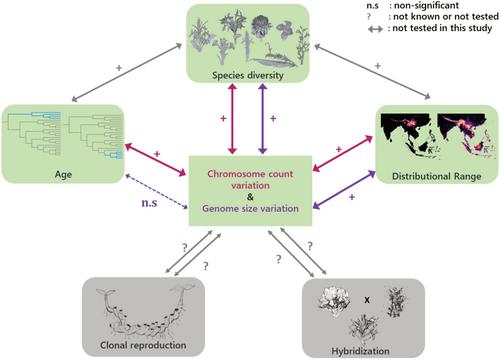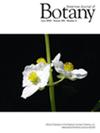Evolutionary patterns of variations in chromosome counts and genome sizes show positive correlations with taxonomic diversity in tropical gingers
Abstract
Premise
Cytogenetic traits such as an organism's chromosome number and genome size are taxonomically critical as they are instrumental in defining angiosperm diversity. Variations in these traits can be traced to evolutionary processes such as polyploidization, although geographic variations across cytogenetic traits remain underexplored. In the pantropical monocot family Zingiberaceae (~1500 species), cytogenetic traits have been well documented; however, the role of these traits in shaping taxonomic diversity and biogeographic patterns of gingers is not known.
Methods
A time-calibrated Bayesian phylogenetic tree was constructed for 290 taxa covering three of the four subfamilies in Zingiberaceae. We tested models of chromosome number and genome size evolution within the family and whether lineage age, taxonomic diversity, and distributional range explain the variations in the cytogenetic traits. Tests were carried out at two taxonomic ranks: within Zingiberaceae and within genus Hedychium using correlations, generalized linear models and phylogenetic least square models.
Results
The most frequent changes in chromosome number within Zingiberaceae were noted to be demi-polyploidization and polyploidization (~57% of the time), followed by ascending dysploidy (~27%). The subfamily Zingiberoideae showed descending dysploidy at its base, while Alpinioideae showed polyploidization at its internal nodes. Although chromosome counts and genome sizes did not corroborate with each other, suggesting that they are not equivalent; higher chromosome number variations and higher genome size variations were associated with higher taxonomic diversity and wider biogeographic distribution.
Conclusions
Within Zingiberaceae, multiple incidences of polyploidization were discovered, and cytogenetic events appear to have reduced the genome sizes and increased taxonomic diversity, distributional ranges and invasiveness.



 求助内容:
求助内容: 应助结果提醒方式:
应助结果提醒方式:


